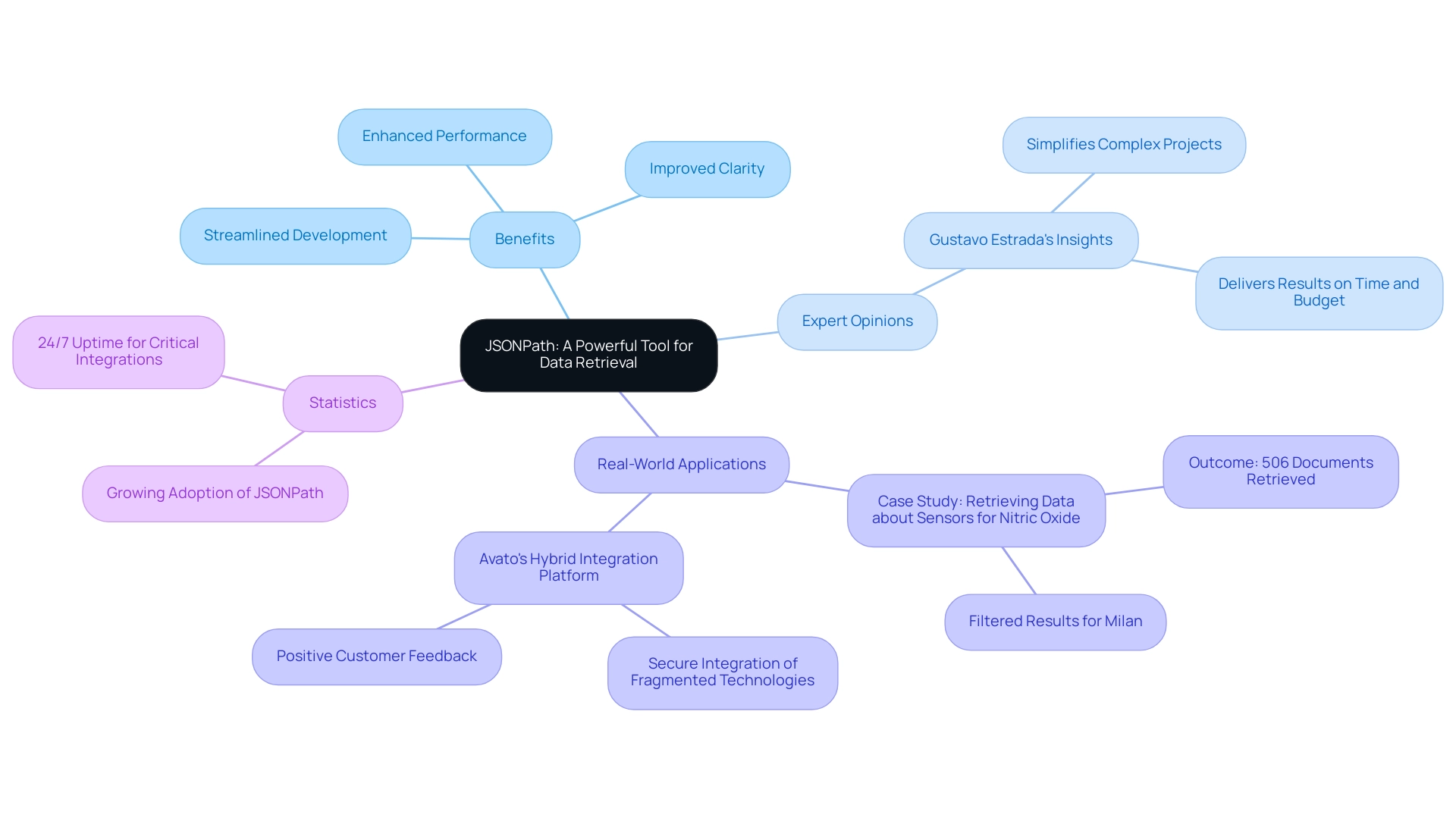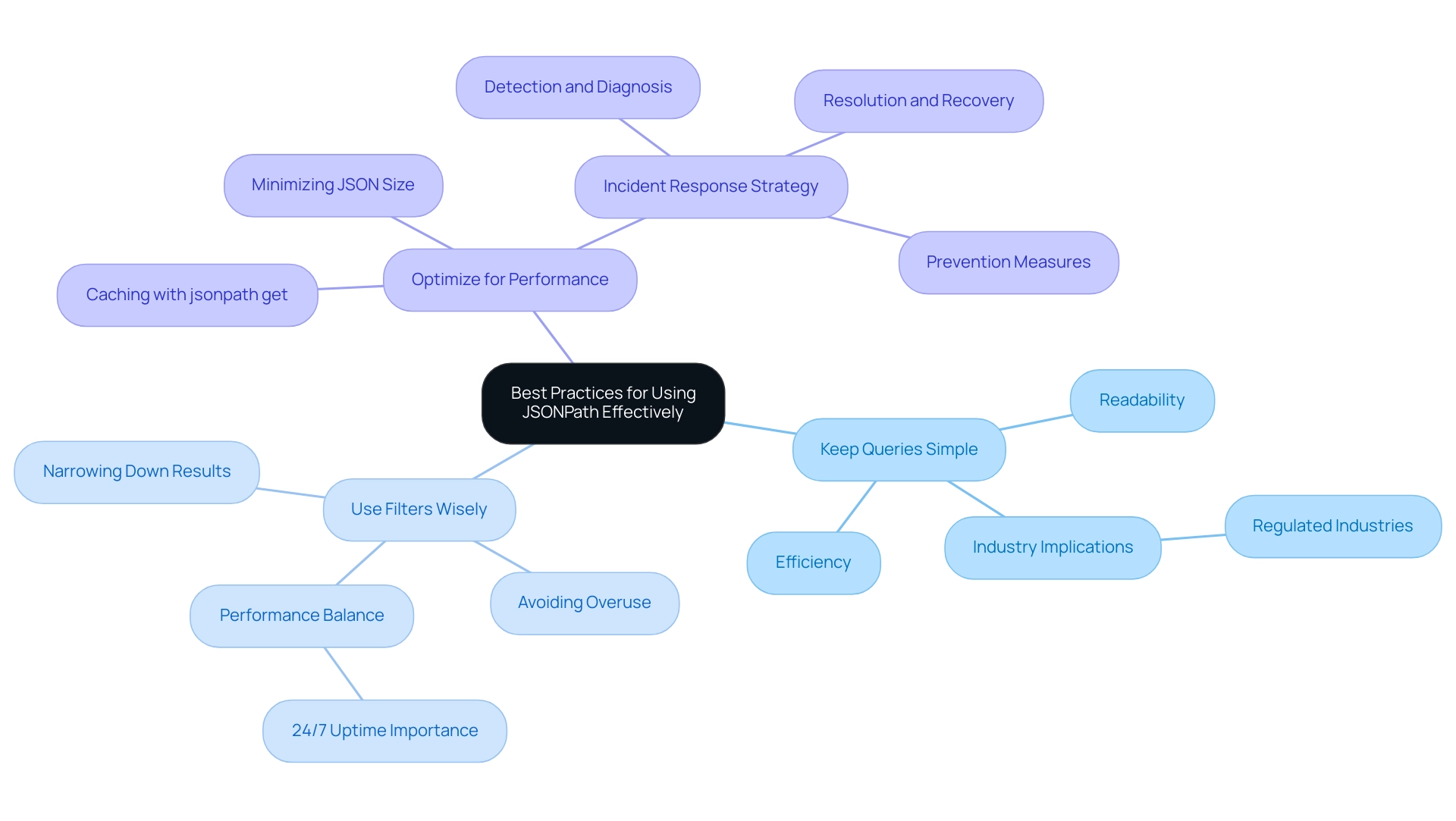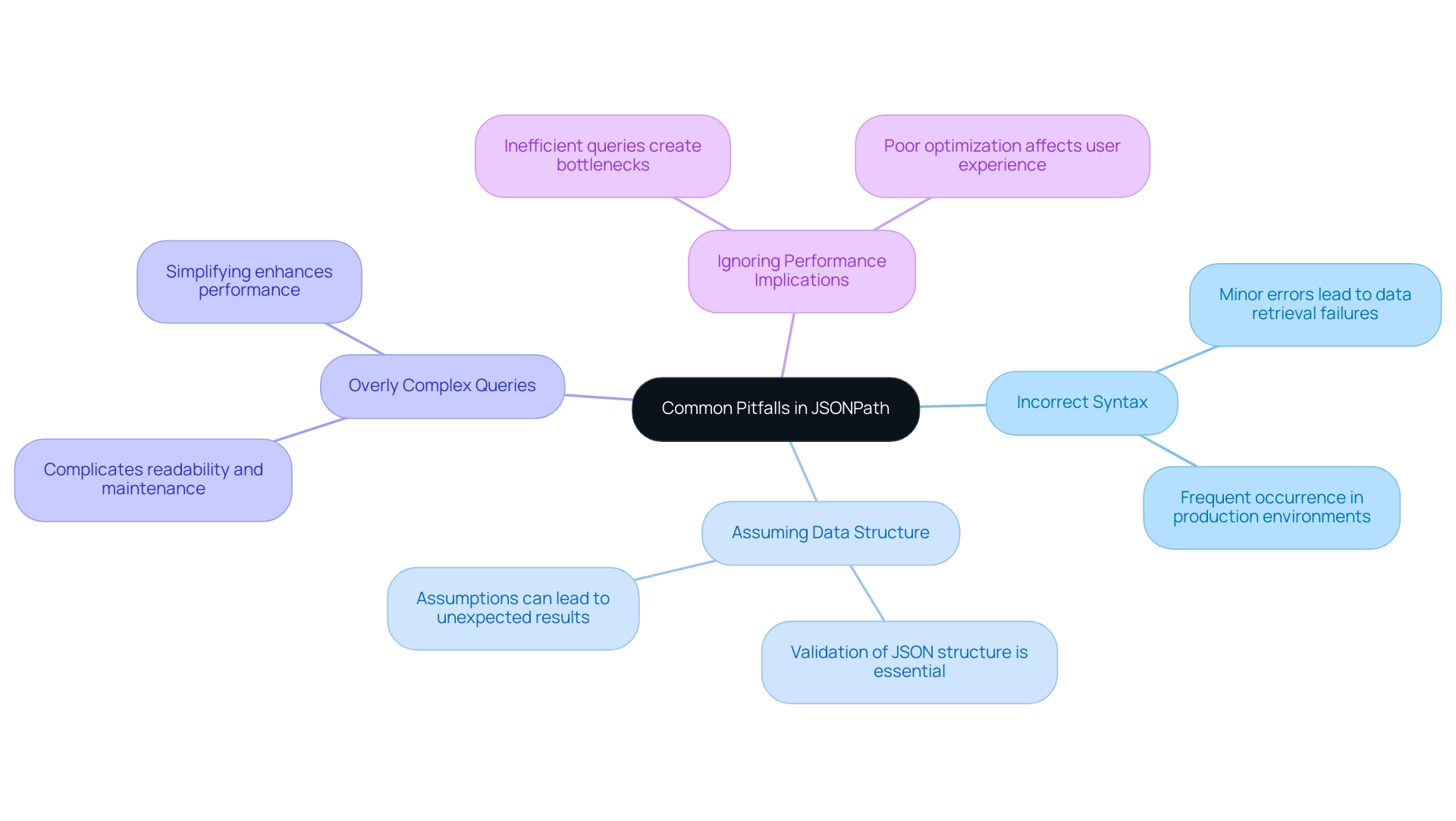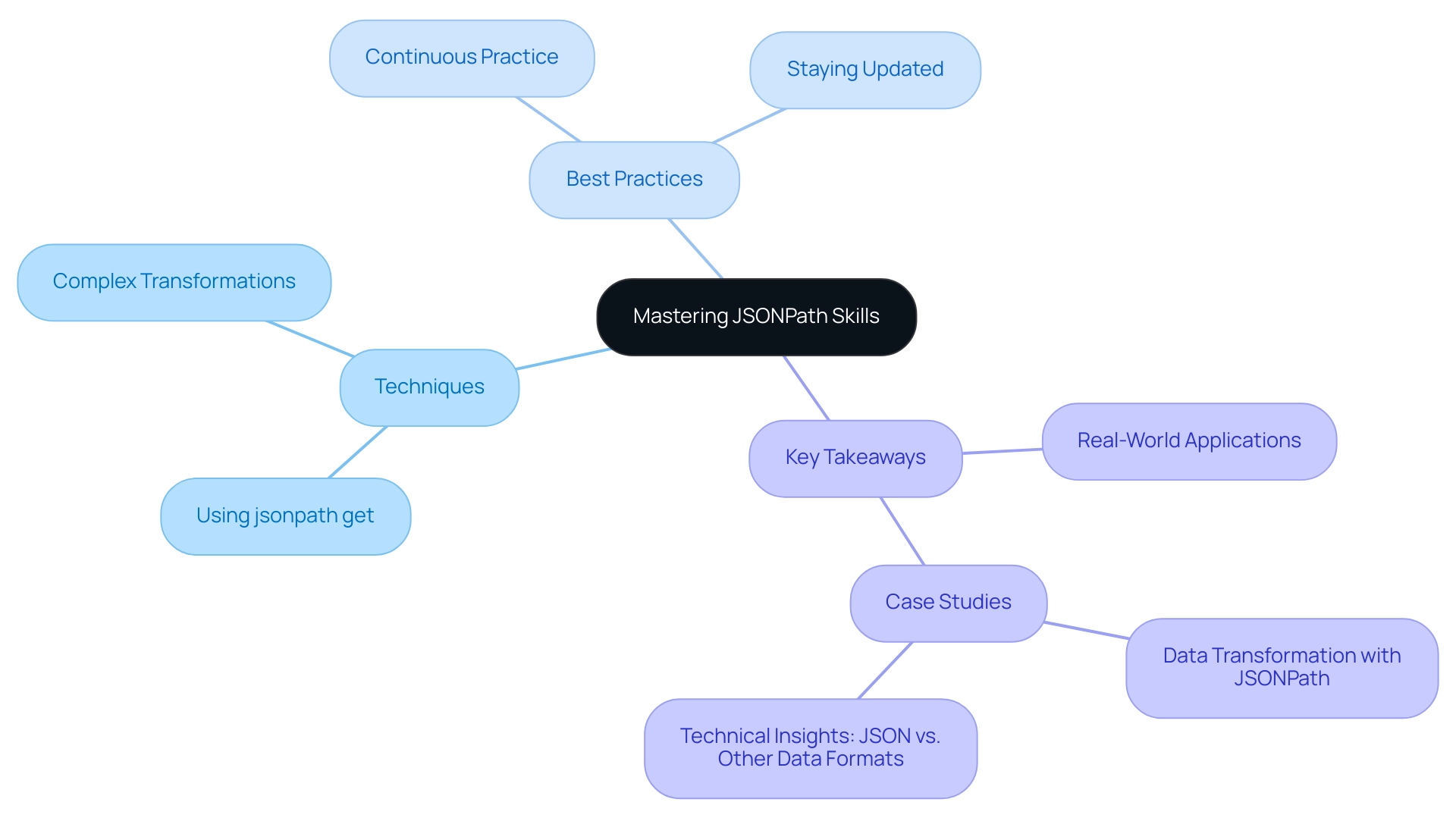Overview
This article delves into best practices for leveraging JSONPath’s get function to optimize data retrieval from JSON structures. It underscores the significance of simplicity in query design, the effective application of filters, and the implementation of performance optimization techniques. Supported by expert insights and real-world applications, these practices not only enhance efficiency but also bolster reliability in environments such as APIs and microservices.
How can these strategies transform your data retrieval processes? Embrace these insights to elevate your approach and achieve remarkable results.
Introduction
In a world increasingly reliant on data-driven decision-making, the ability to efficiently extract and manipulate information from complex JSON structures has never been more vital. JSONPath emerges as a powerful query language specifically designed for this purpose, enabling developers to navigate intricate data landscapes with precision and ease. As organizations strive to optimize their API interactions and microservices architectures, understanding JSONPath’s capabilities becomes essential.
Recent advancements have not only improved data retrieval processes but have also significantly enhanced performance metrics. As a result, JSONPath stands out as an indispensable tool in today’s tech-driven environment. This article delves into the nuances of JSONPath, exploring its syntax, common use cases, best practices, and advanced techniques that can elevate data handling to new heights. Are you ready to unlock the full potential of your data? Let’s explore how JSONPath can transform your approach to data management.
Understanding JSONPath: A Powerful Tool for Data Retrieval
JSON querying stands as a powerful query language tailored for JSON formats, empowering users to employ jsonpath get to effortlessly extract specific elements from complex JSON structures. This tool significantly enhances the navigation of JSON documents, enabling developers to craft concise queries that yield only the essential information. Such precision not only boosts performance but also elevates clarity in information management—an imperative in environments where data is frequently exchanged, particularly within APIs and microservices architectures.
Recent advancements in JSON querying have dramatically reshaped information management in APIs throughout 2025. This tool has emerged as essential for optimizing API performance metrics by facilitating more efficient information retrieval with jsonpath get. For instance, organizations leveraging similar query languages have reported notable improvements in response times and reduced server load, underscoring its efficacy in high-demand environments.
The dedicated hybrid integration platform guarantees 24/7 uptime for essential integrations, underscoring the reliability of utilizing this query language in such contexts.
Expert opinions highlight the myriad advantages of employing this query language for information retrieval. Industry leaders assert that its capacity to simplify complex queries accelerates development cycles and fosters more maintainable code. This is particularly significant in the banking sector, where information integrity and speed are of utmost importance.
Gustavo Estrada, a client, noted Avato’s ability to streamline intricate projects and deliver outcomes within preferred time constraints and financial limitations, emphasizing the critical role of effective information retrieval tools.
The relevance of such tools transcends mere information extraction; they play a crucial role in the jsonpath get structure of microservices. By enabling seamless information retrieval across distributed systems, this tool enhances interoperability and supports agile development practices through jsonpath get. Real-world examples illustrate its application in microservices architectures, where teams have effectively employed alternatives to streamline interactions between services, resulting in improved operational efficiency.
The Hybrid Integration Platform exemplifies how such solutions can facilitate the use of path expressions in practical scenarios, ensuring structured and compliant data integration.
Current statistics reveal a growing adoption of jsonpath get for path expressions in data retrieval processes, with many organizations acknowledging its potential to enhance data management strategies. As businesses continue to navigate the complexities of digital transformation, the role of jsonpath get in API and microservices architectures will only become more critical, solidifying its status as an indispensable tool for modern developers. Avato’s commitment to delivering a reliable, future-ready technology stack further underscores the importance of utilizing tools such as the JSON query language to adapt to evolving requirements in the banking sector.

JSONPath Syntax: Mastering the Basics
The fundamental syntax of JSON querying is crafted to facilitate seamless navigation through JSON structures, comprising several key components essential for effective information retrieval:
- Root Node: Denoted by
$, this symbol marks the starting point of the JSON document, serving as the foundation for all subsequent queries. - Child Operator: The dot (
.) operator allows users to access child elements directly, enabling straightforward navigation through nested structures. - Array Indexing: Square brackets (
[]) are utilized to access specific elements within arrays. This feature supports both direct index access and filtering capabilities, enhancing the flexibility of queries. - Wildcards: The asterisk (
*) serves as a wildcard, enabling the selection of all elements at a given level, which is particularly useful for retrieving multiple items without specifying each one individually.
For instance, the expression $.store.book[*].author effectively retrieves the authors of all books available in the store, showcasing how these components work together to form powerful queries. Mastering these elements is essential for creating effective queries, as it not only streamlines the retrieval process but also reduces typical mistakes that can result in errors. Statistics indicate that a significant percentage of developers encounter challenges with syntax, often due to misunderstandings of these basic components. By becoming acquainted with the syntax and following best practices, developers can enhance their skills in using JSONPath, particularly in how to jsonpath get data within enterprise applications, ultimately resulting in more effective information management and retrieval.
In the context of banking, where reliability is crucial, the company guarantees 24/7 availability for essential connections, allowing IT managers to concentrate on innovation without concern for system outages. The hybrid integration platform of the company illustrates the benefits of JSON compared to XML, especially in streamlining intricate integration initiatives and improving information interchange efficiency. JSON’s lightweight nature reduces markup overhead, making it easier to parse and transfer data compared to XML, which can be cumbersome due to its extensive markup.
A case study on the platform illustrates its effectiveness in enabling organizations to achieve their goals swiftly and efficiently. As Gustavo Estrada, a client, observed, the platform excels in delivering results within desired time frames and budget constraints, reinforcing its value in addressing connectivity challenges. Furthermore, the company differentiates itself in the market by offering speed, security, and simplicity in integration, making it an ideal choice for banking IT managers seeking to modernize their operations.
Common Use Cases for JSONPath in Data Retrieval
The syntax for querying JSON, such as jsonpath get, serves as a powerful tool that enhances information manipulation and retrieval efficiency across multiple scenarios. This aligns seamlessly with Avato’s commitment to simplifying disparate systems and maximizing business value. Its applications include:
- API Response Processing: The tool excels in extracting specific fields from JSON responses returned by APIs. This capability empowers developers to focus exclusively on essential information, streamlining workflows and overall efficiency. For example, in the case study titled ‘Simplifying API Testing with Alternative Expressions,’ these expressions were employed to validate specific data points in API responses, leading to concise assertions that bolster test maintainability and ensure reliable API interactions. This commitment aligns with Avato’s dedication to ensuring 24/7 uptime for critical integrations, providing a robust foundation for API reliability.
- Configuration Management: In the realm of configuration management, a querying language facilitates access to configuration settings stored in JSON format. This dynamic approach enables applications to adapt their configurations on-the-fly, ensuring responsiveness to changing operational requirements without extensive reprogramming.
- Data Transformation: JSONPath plays a crucial role in transforming JSON structures for reporting or analytics purposes. By utilizing jsonpath get for targeted information extraction and manipulation, it supports the creation of tailored reports that address specific business needs, thereby enhancing decision-making processes. Avato’s expertise in information transformation guarantees that clients can harness these capabilities effectively through its hybrid integration platform, featuring advanced transformation, routing, and aggregation capabilities.
- Testing and Validation: Automated testing frameworks increasingly leverage jsonpath get as a query language to validate the structure and content of JSON responses. This practice not only enhances the reliability of tests but also ensures that API interactions conform to expected standards, thereby mitigating the risk of errors in production environments. As highlighted by Gustavo Estrada, the platform simplifies complex projects and delivers results within desired time frames and budget limitations. This further validates the effectiveness of using this query language in conjunction with the platform. These diverse use cases underscore the versatility of this technology, making it an essential tool for developers and IT managers in the banking sector who aim to optimize data retrieval and processing within their organizations while enhancing operational visibility and issue resolution.
Best Practices for Using JSONPath Effectively
To maximize the effectiveness of JSONPath within the Hybrid Integration Platform, consider the following best practices:
- Keep Queries Simple: While JSONPath supports complex queries, simpler queries are often more efficient and easier to maintain. This method not only improves readability but also decreases the likelihood of mistakes, resulting in smoother assimilation processes. As Gustavo Estrada noted, Avato simplifies complex projects and delivers results within desired time frames and budget constraints, underscoring the importance of simplicity in query design, especially in regulated industries.
- Use Filters Wisely: Leverage filters to narrow down results effectively, but be cautious of overusing them, as excessive filtering can degrade query performance. Finding an equilibrium is essential for sustaining optimal speed, which is vital for guaranteeing 24/7 uptime for critical connections, especially in the banking industry where dependability is crucial. Validating the structure with
jsonpath gethelps prevent runtime errors and ensures that queries execute as intended, which is particularly important in regulated environments where compliance is essential. - Optimize for Performance: Consider using
jsonpath getfor caching frequently accessed information and minimizing the size of JSON documents. These strategies can significantly enhance retrieval speed, which is essential for maintaining 24/7 uptime for critical systems. Moreover, possessing a clear strategy for incident response and remediation is essential for managing API performance challenges effectively, ensuring that any possible disruptions are handled swiftly.
By following these best practices, users can improve their data retrieval processes, simplify collaboration efforts, and decrease the chances of errors, ultimately resulting in more efficient operations. Furthermore, effective communication practices, as emphasized in the case studies, can significantly enhance the integration process, ensuring that all stakeholders are informed and aligned throughout the project, thereby future-proofing systems and optimizing integration strategies.
Get your copy now to learn more about how this organization can help you streamline your integration processes and manage structured requirements effectively.
FAQs:
- How can I mobilize stakeholders to get requirements right the first time?
- Engage them early in the process and ensure clear communication of goals and expectations.
- What tools can I use to illustrate the current state and ideal state?
- Utilize modeling tools that allow for visual representation of processes and requirements.
- How does this company assist in future-proofing systems?
- Avato’s solutions are designed to integrate seamlessly with existing assets, ensuring adaptability to new technologies.

Common Pitfalls to Avoid When Using JSONPath
When utilizing JSONPath, it is crucial to be aware of several common pitfalls that can hinder effective data retrieval.
- Incorrect Syntax: JSONPath expressions must be accurately formatted; even minor syntax errors can result in failed data retrieval. Research indicates that incorrect JSONPath syntax occurs frequently in production environments, leading to significant delays in project timelines.
- Assuming Data Structure: It is essential to validate the structure of the JSON information before querying. Many developers have encountered issues stemming from assumptions about information formats, which can lead to unexpected results and wasted resources.
- Overly Complex Queries: Crafting overly complex queries can complicate readability and maintenance. Simplifying queries not only enhances clarity but also improves performance, particularly when dealing with large datasets.
- Ignoring Performance Implications: Inefficient queries can create performance bottlenecks, especially in high-volume environments. Statistics indicate that poorly optimized queries can significantly affect application responsiveness and user experience.
By identifying and tackling these pitfalls, users can enhance their proficiency with jsonpath get, leading to more effective information handling and improved operational efficiency. For instance, a case study on the jsonpath get method for extracting and converting web JSON information into a Pandas Data Frame illustrates the importance of proper JSON manipulation techniques, showcasing how effective handling can streamline processes and enhance analytical capabilities.
Incorporating best practices and validating JSON structures before performing a jsonpath get query are essential steps in avoiding common mistakes. Developers highlight the significance of comprehensive testing and validation to prevent errors that could disrupt coordination efforts. As Gustavo Estrada, a client, remarked, “The company has simplified complex projects and delivered results within desired time frames and budget limitations,” emphasizing the influence of efficient information retrieval on project success.
Moreover, Avato guarantees 24/7 availability for essential connections, highlighting the significance of reliability in information retrieval processes using jsonpath get. By implementing these strategies, organizations can utilize jsonpath get expressions more effectively, ensuring optimal information retrieval and merging results. Current research also concentrates on improving JSON’s capabilities, including temporal information management and interoperability in IoT applications, further highlighting the significance of jsonpath get for querying JSON in contemporary projects.
Avato’s dedication to pioneering hybrid integration solutions establishes it as a leader in connecting legacy systems and modern expectations, ultimately enabling businesses to future-proof their operations through seamless information and system integration.

Advanced JSONPath Techniques for Enhanced Data Retrieval
To elevate your JSONPath expertise, consider implementing the following advanced techniques:
- Utilizing Recursive Descent: The
..operator is a powerful tool that facilitates recursive descent through the JSON structure. This enables users to utilize jsonpath get to find elements at any tier within the hierarchy, significantly improving the flexibility of retrieval. In enterprise applications, this technique has proven effective in navigating complex JSON documents, allowing users to efficiently use jsonpath get to extract pertinent information. JSON’s streamlined structure, in contrast to XML’s verbose markup, makes it particularly advantageous for hybrid integration platforms, which are utilized across various sectors, including agriculture applications in Henan Province, China, showcasing its versatility. - Combining Filters: By employing multiple filters within a single query, users can refine their results based on various criteria. This approach enhances the specificity of information retrieval and leverages jsonpath get to streamline the process of extracting targeted details from large datasets. Advanced filtering techniques have been shown to improve query performance, making them essential for data-driven decision-making in sectors like banking and healthcare. As Gustavo Estrada from BC Provincial Health Services Authority pointed out, Avato simplifies complex projects and delivers results within desired time frames and budget constraints, underscoring the importance of effective information retrieval techniques.
- Leveraging Wildcards: Wildcards serve as a valuable asset when dealing with unknown or variable information structures. They simplify queries by allowing users to match patterns rather than specific values, which is especially beneficial in dynamic environments where formats may change frequently.
These advanced techniques empower users to utilize jsonpath get to construct more sophisticated queries, thereby enhancing their ability to extract and manipulate information effectively. The organized approach to information science, as outlined in the case study titled ‘Science Process Overview,’ illustrates how these methods can lead to enhanced business practices and decision-making. Moreover, the significance of transfer learning in improving efficiency in deep learning applications connects to the wider theme of information retrieval and manipulation.
As organizations increasingly depend on information-driven insights, mastering these methods will be crucial for optimizing information retrieval processes in 2025 and beyond. This information is contextualized within the framework of the ‘Data Transformation and Integration Resources’ discussed on May 7, 2019.
Optimizing Performance: Tips for Faster JSONPath Queries
To enhance the performance of JSONPath queries, implementing several key strategies is essential.
- Minimize Size: Streamlining JSON documents by removing extraneous information can lead to significant improvements in query execution speed. Reducing the overall information size not only accelerates processing but also minimizes the load on system resources, which is crucial in high-demand environments like banking and healthcare.
- Utilize Caching: Employing caching strategies for frequently accessed information can drastically decrease retrieval times. By storing the results of common queries, systems can bypass the need to reprocess data, leading to faster response times. Real-world examples demonstrate that effective caching can reduce query latency by up to 70%, making it a vital technique for optimizing performance.
- Profile Queries: Regular profiling and analysis of query performance are critical for identifying bottlenecks. By systematically reviewing how queries perform under various conditions, organizations can utilize
jsonpath getto pinpoint inefficiencies and make informed adjustments. This proactive approach not only enhances performance but also aligns with best practices in managing complex projects.
These performance optimization strategies are particularly important in sectors where operational reliability and speed are paramount. The hybrid connectivity platform plays a crucial role in executing these strategies, ensuring smooth unification and improved performance. The company’s commitment to ensuring 24/7 uptime for critical integrations underscores the significance of these strategies in maintaining seamless operations.
As pointed out by Gustavo Estrada, a client of the service, the platform simplifies intricate projects and provides outcomes within preferred timelines and budget limitations. This demonstrates how these optimization methods directly enhance performance in query processes. Furthermore, the dependable, future-proof technology stack supports businesses in adapting to changing demands and enhancing operational capabilities, addressing the challenges of integrating isolated legacy systems and fragmented data. By concentrating on these strategies, users can significantly enhance the efficiency of their queries with jsonpath get, ultimately leading to improved application performance and a more seamless integration experience.
Avato, derived from the Hungarian word for ‘of dedication,’ embodies a deep commitment to architecting the technology foundation required to power rich, connected customer experiences.
Key Takeaways: Maximizing Your JSONPath Skills
Mastering this query language is essential for optimizing information retrieval and enhancing overall information handling capabilities. To effectively utilize the query language, users must familiarize themselves with its syntax and recognize common use cases, such as employing jsonpath get for extraction from APIs and configuration files. Applying best practices is crucial to prevent typical obstacles, ensuring that information retrieval methods are both efficient and dependable.
Sophisticated techniques in querying can yield substantial performance enhancements. For instance, using a query language for complex transformations empowers users to reshape structures based on specific needs, streamlining manipulation tasks. This capability not only enhances efficiency but also supports better decision-making through improved information accessibility.
The commitment to ensuring continuous uptime for essential integrations underscores the reliability of utilizing this technique in information retrieval processes.
Statistics reveal that organizations proficient in this method can achieve significant efficiency improvements, with quicker information retrieval times and reduced processing overhead. As the demand for flexible information management continues to grow, the ability to navigate JSON expressions effectively will become increasingly valuable. Gustavo Estrada, a client, noted the company’s capacity to streamline intricate projects and deliver outcomes within preferred timelines and budget constraints, highlighting the importance of mastering tools such as similar query languages.
Industry leaders emphasize the future of such query languages in information retrieval, showcasing their adaptability in depicting hierarchical structures and accommodating various types. This adaptability positions the jsonpath get as a critical tool for businesses aiming to modernize their information strategies, particularly with Avato’s reliable, future-proof technology stack that enables organizations to adapt to evolving demands in information handling.
Key takeaways for mastering JSONPath in 2025 include:
- Continuous practice and application of skills to enhance proficiency.
- Staying updated on best practices and emerging techniques to maintain a competitive edge.
- Leveraging real-world examples and case studies to understand practical applications and outcomes.
For example, a recent case study on information transformation demonstrated how businesses can utilize jsonpath get to simplify complex information mapping tasks, leading to more effective information management. By embracing these insights and techniques, users can significantly enhance their retrieval capabilities, ensuring they are well-equipped to meet the evolving demands of the digital landscape. Avato’s comprehensive integration solutions and expertise in data transformation further empower organizations to navigate these challenges successfully.

Conclusion
Mastering JSONPath is a pivotal step for developers and organizations aiming to optimize data retrieval and enhance operational efficiency. This article has thoroughly explored the fundamentals of JSONPath, highlighting its powerful syntax and versatility in addressing complex data structures. From extracting specific fields in API responses to managing configurations and automating testing, JSONPath proves to be an essential tool in modern data management strategies.
Furthermore, the importance of best practices cannot be overstated. By simplifying queries, using filters judiciously, and validating JSON structures, users can mitigate common pitfalls that often hinder effective data retrieval. Advanced techniques, such as recursive descent and wildcard usage, further empower users to craft sophisticated queries that cater to dynamic data environments.
As organizations continue to navigate the complexities of digital transformation, the role of JSONPath will only grow in significance. With proven capabilities to enhance performance metrics in high-demand sectors like banking, the strategic implementation of JSONPath can lead to substantial efficiency gains and improved decision-making processes. The commitment to reliability and performance, exemplified by platforms like Avato, underscores the critical nature of these tools in achieving seamless integration and operational excellence.
Ultimately, embracing JSONPath not only equips developers with the skills to handle intricate data landscapes but also prepares organizations to adapt to the ever-evolving demands of the digital world. Through continuous practice and a focus on emerging techniques, mastering JSONPath will undoubtedly elevate data management capabilities and drive future success in data-driven initiatives.

